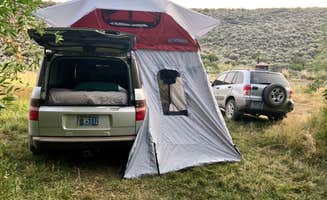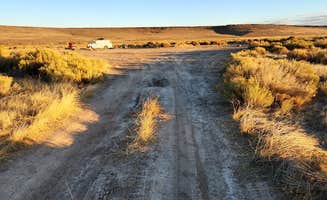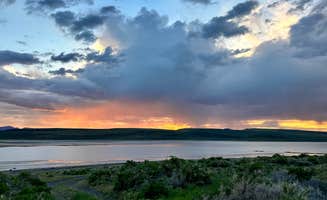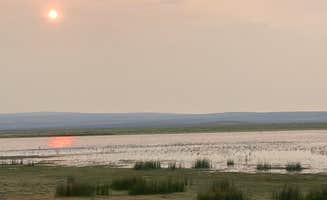Dispersed camping near Adel, Oregon centers around public lands managed by the Bureau of Land Management and wildlife refuges in this remote southeastern Oregon region. Elevation in the area ranges from 4,500 to over 7,000 feet, creating significant temperature fluctuations between day and night. Access to most rustic camping locations requires travel on unpaved roads that can become impassable after heavy rain or snow events, with conditions worsening significantly during winter months.
What to do
Fishing opportunities: Catnip Reservoir within the Sheldon National Antelope Refuge offers fishing for cutthroat trout. According to a camper at Catnip Reservoir Dispersed Camping, "Reservoir active with waterfowl & other birds. Coyotes at night. Fishing for cutthroat trout. Other than fishing and star gazing, there is not much to do here, but I really liked this location."
Wildlife observation: The Warner Valley wetlands provide excellent bird watching opportunities. A visitor to Burshy Point Dispersed Camping shared, "We drove our van right up near the water in a quiet nook. Spent one night enjoying the many shore birds, a beautiful sunset and a refreshing cool night. I would not recommend swimming in this active wildlife reservoir!"
Stargazing sessions: With minimal light pollution, the area offers exceptional night sky viewing. Wait until after midnight when highway traffic diminishes for optimal viewing conditions. Pack red-light headlamps to maintain night vision while setting up equipment.
What campers like
Privacy between sites: Though vegetation is sparse, most camping areas provide adequate space between sites. One camper at Camp Hart Mountain noted, "The sites aren't that private due to lack of vegetation but they are spaced far enough apart that you have a sense of privacy. There are some very dark skies here."
Historic features: Some campgrounds contain remnants of historic structures. At Camp Hart Mountain, a visitor mentioned, "This is a free campground at a former CCC camp in use during the Great Depression. Crews house here built the Hart Mountain road that passes through the Hart Mountain Antelope Refuge. The bunkhouse remains."
Waterside camping: Several sites offer direct access to water features. A camper at Lake Abert US 395 South Pullout Dispersed Camping reported, "We found refuge for the night off one of the little pullouts and set up camp right by the water. Highway was a little noisy but nothing too bad as it was quiet in the middle of the night. Sunset was perfect."
What you should know
Limited cell coverage: Connectivity is unreliable throughout the region. One review for Lake Abert noted, "AT&T coverage was fair, with 3 bars of LTE and speeds up to 3 MB/s," but this is unusually good for the area and should not be expected at most locations.
Water availability: Potable water sources are scarce. According to a reviewer at Hogback Road Dispersed, "This site was free and fine for one night if you're in the area, but don't expect any privacy or amenities."
Weather preparation: Conditions can change rapidly in this high desert environment. Wind gusts frequently exceed 30 mph, especially during afternoon hours. Temperature swings of 40+ degrees between day and night are common, requiring both sun protection and warm layers.
Sanitation concerns: Some locations suffer from improper waste disposal. One camper reported, "However, some disgusting person left a large nasty pile of feces soiled jeans, pee pad, wipes, etc. lying in a heap by one of the gravel mounds. It has now been bagged and removed so others won't have it detract from their stay."
Tips for camping with families
Water recreation limitations: Many water bodies in the region aren't suitable for swimming. A visitor to Burshy Point warned, "Not sure you can swim in the water, didn't have my water shoes on to try. It looked like more like a pond on shore could be mucky. Not a long drive in, didn't look like a place to swim."
Wildlife viewing opportunities: Early morning provides optimal wildlife sightings for children. A camper at Hogback Road Dispersed shared, "In the morning, we awoke to a beautiful sunrise and sounds of migrating birds taking flight from their nighttime stopover at (mostly dried up) Crump Lake, across the street. We also enjoyed watching a herd of Bighorn sheep grazing by the side of the road."
Insect protection: Mosquitoes can be problematic near water sources. One visitor warned, "If you stay by the creek, expect mosquitos." Pack long-sleeved clothing and repellent, especially during late spring and early summer when populations peak.
Tips from RVers
Rig size considerations: Most rustic camping areas near Adel can accommodate small to medium RVs, but access for larger rigs is limited. At Lake Abert, one full-time RVer noted, "We are full-timers and have a 36 ft Class A with a Cherokee Trailhawk tow. We stayed for one night here in late May. Pretty much what everyone else has said- quiet behind the gravel mounds, very little traffic on US 395, especially at night, a really nice place."
Water fill locations: Portable water containers are essential. A camper at Camp Hart Mountain advised, "Fill up on water when you get to the little ranger station so you don't have to pack water up the hill."
Road condition awareness: Many access roads require high clearance vehicles. Plan extra travel time, as washboarded and rutted roads often necessitate speeds under 15 mph on approach routes to most dispersed camping locations.





